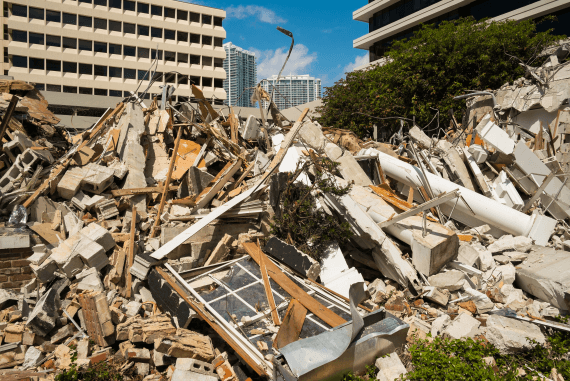- Home ››
- Health and Safety Training ››
- Manual Handling Training ›› Manual Handling During Demolition
Manual Handling During Demolition
Introduction

Demolition work can be extremely dangerous and hazardous to the health and safety of all those involved. This includes nearby members of the public, who will be potentially at risk if certain safety measures are not put in place and enforced, such as a perimeter fence at a minimum safe distance to keep unauthorised personnel away from the demolition site.
With so many possible risks, many of which can result in serious injuries or have fatal consequences for those unfortunate enough to be caught up in any accident, it means that demolition work demands thorough and competent health and safety people and systems in place, in order to minimise the risks as far as is reasonably practical.
Manual Handling During/After Demolition
One such hazard which may not be the most dangerous in terms of being life-threatening, but can still have serious negative consequences for the health and well-being of company employees, is manual handling during demolition works.
Demolition is not all about using explosives or giant wrecking balls to knock down a building; a significant part of it involves a person moving small fragments of demolished material off the site.
The sheer amount of small pieces of material that can be created during a controlled explosion or wrecking ball impact means that there is usually a lot to clear. Most will be cleared by an excavator type machine or similar, but even so, there will inevitably be lots of smaller pieces which need to be cleared by hand.
Suitable manual handling training must be provided beforehand to try and prevent manual handling injuries from occurring.
Additional Risks
As well as posing a manual handling risk, there are also likely to be additional hazards associated with these pieces.
For example, because these objects (or "the load" in manual handling speak) have been broken up into small pieces during the demolition process, many are likely to have sharp edges. Material such as brick, concrete, wood etc that has been broken and has jagged edges can cause serious injuries to a person. Appropriate measures, including but not limited to the provision and correct usage of Personal Protective Equipment (PPE) must be taken to keep workers safe from harm, as far as is reasonably practical.
There also exists the possibility of there being hazardous substances present, such as asbestos dust, which could cause serious health issues if inhaled. Even ordinary dust (i.e. not asbestos dust) created by demolition can still pose a risk in large quantities. For instance, a person with asthma could be severely affected by this large dust cloud and lead to them having difficulties breathing.
It is highly unusual for a building or object to be completely razed to the ground in one instant. This means that demolition work will also leave parts of structures which are extremely unstable, even if it is just for a little while before the next wave of demolition work commences. There needs to be processes and procedures in place to ensure that only those workers who are meant to be near them are in the vicinity, and that everyone else is kept well away for their own safety.
New technology can be introduced on the site in order to assist demolition workers with manual handling. This can include hoists and winches to assist with lifting objects, or machines to help take debris away rather than a worker having to carry the load.
The Need for Manual Handling Training
As far as manual handling is concerned, workers need to be well trained in safe manual handling techniques, particularly as they are likely to be lifting and moving objects for a significant amount of time (i.e. most of the day). Significant damage can be done to the body by just one incorrect manual handling manipulation technique, but problems can often be further compounded by repeating the action over and over.
Many people fall into bad habits in terms of lifting. Quite often a young body can get away with not using the optimal technique, but for older people, or when performed over a long period of time, the strain on the body can result in injuries. Whilst demolition workers are likely to be on their feet whilst moving objects, and so will not really encounter risks from sitting rather than standing that workers in other industries such as a factory production line may experience, they still need to be taught information regarding safe lifting and moving techniques.
These injuries can be both extremely painful and debilitating, restricting movement and making even everyday tasks difficult or impossible to do, let alone trying to perform workplace duties. It is for this reason that safe lifting techniques are such an important topic to be covered during any manual handling or general health and safety courses.
Conclusion
Like all health and safety in a place of work, safe manual handling is the responsibility of all. Not only do managers need to arrange and provide extensive training for workers, but these employees also need to take responsibility for themselves in terms of following the instructions and knowledge provided, so that they work safely and reduce the likelihood of them suffering an injury. It is in their own best interests, as well as those of management, after all.
The ease and commonality of manual handling injuries means that manual handling training is important and necessary, not only for those workers engaged in the demolition and construction industries, but will also prove highly beneficial for any company employee (and is even worthwhile for their personal lives when they move boxes and lift awkward objects).
The potential serious injuries and dangers of incorrect manual handling techniques, such as slipped discs and hernias, as well as more minor yet still painful and debilitating ones like sprains and muscle pulls, mean that manual handling considerations should be taken into account at all times by those working on a demolition site.


